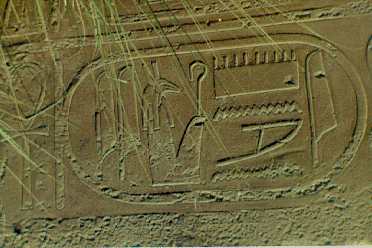


Next: Stereotyped formulas
Up: A few frequent words
Previous: Names of people
The kings had multiple names, the number of which varied with time. The
classical titelature is five names long. These names are :
- the Horus name
- is the older name for Egyptian kings. It was
written enclosed in a panel called a serekh, which represented a
palace. The word ``serekh'' means ``make to know'', and thus
indicate that the panel is a proclamation of the king's name.
 is the Horus name of Ramesses II; it means
is the Horus name of Ramesses II; it means
strong bull loved by (or loving) Maat
- The two mistress name
- links the king to the patron goddesses
of Upper and Lower Egypt, Nekhbet and Ouadjet. It is indicated by
the signs
 , and reads nebty so in this example
, and reads nebty so in this example
 which is the nbty-name of Ramses II:
which is the nbty-name of Ramses II:
The two mistress, the protector of Egypt, he who strikes the
foreign countries
- The golden Horus name
- is another name, preceded by

still Ramesses :

The Golden Horus, powerful by his years of victory
- The King of Lower and Upper Egypt name
- is one of the two mostly
used names of the king. Its is preceded by the signs
 which read ``king of Upper and Lower Egypt'',
and is enclosed in a cartouche. Ancient Egyptian usually used this
name for their king.
which read ``king of Upper and Lower Egypt'',
and is enclosed in a cartouche. Ancient Egyptian usually used this
name for their king.
Ramesses for ever:
The king of Upper and Lower Egypt, Ouser-Maat-Re Setep-en-Re
(Powerful by the Maat of Re, the chosen of Re)
- The son of Re
- is the ``birth name'', that is, the name of
the king when he was still a prince. It is this name we use when we
speak of ``Ramses II'' or ``Tuthmosis III''.
It is preceded by
 and enclosed in a cartouche.
and enclosed in a cartouche.
 writes the word ``son'', because the name of the
duck and the word ``son'' have the same consonants in Egyptian,
and
writes the word ``son'', because the name of the
duck and the word ``son'' have the same consonants in Egyptian,
and
 spells ``Re'', the sun-god.
spells ``Re'', the sun-god.

And, at last, Ramses:
The son of Re, Ra-mes-su meri-Amon (It is Re who gave birth to
him, the one whom Amon loves)
And here is the full titelature for Ramses II:

Actually, the titelature of a king could change, not only during his
reign, but also, especially when it came to the various epithets,
according to the place. The titelature was some kind of a political
program.

An interesting example is Sethy
 the first, whose name Sethy refers to
the god Seth. As the relations between Seth and Osiris are quite
bad since the murder of the latter by the former, in Osirian contexts,
(for example, in Sethy's tomb) Sethy's name is written
the first, whose name Sethy refers to
the god Seth. As the relations between Seth and Osiris are quite
bad since the murder of the latter by the former, in Osirian contexts,
(for example, in Sethy's tomb) Sethy's name is written
 with the sign
with the sign
 for
Osiris instead of
for
Osiris instead of
 , which is Seth.
, which is Seth.



Next: Stereotyped formulas
Up: A few frequent words
Previous: Names of people
Serge Rosmorduc
2/26/1998
![]() is the Horus name of Ramesses II; it means
is the Horus name of Ramesses II; it means
![]() which is the nbty-name of Ramses II:
which is the nbty-name of Ramses II:
![]()
![]()

